Israel-Jordan-Egypt with Suez Canal Cruise
January 2018
Day 1 Tel Aviv
Today we are in Tel Aviv, tomorrow we cross the Jordan and stay at the Dead Sea.
Tel Aviv is a modern financial/tech center
We explored some of Jerusalem on our own yesterday. I had an adventure trying to buy a light rail ticket to Yad Vashem, the Holocaust Memorial. I neglected to see the English button and ended up buying 2 tickets for a blind person and guide. The conductor did not seem to care. The last time I could actually read Hebrew was about 50 years ago!
The train carried many young soldiers, both male and female with their machine guns at hand. 
Had a nice walk along the beach today and found a tasty crepe shop.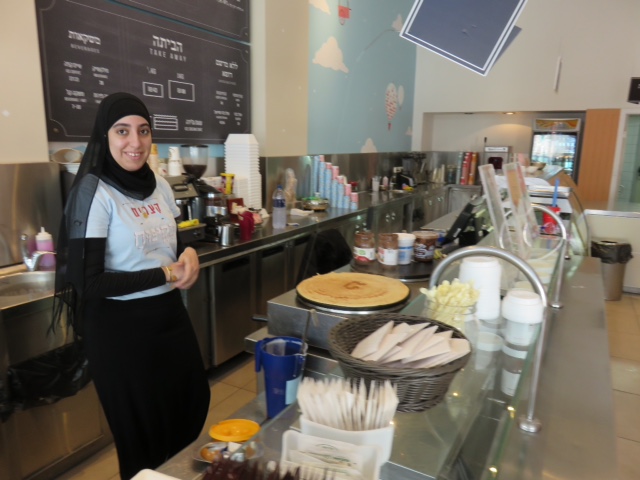
......................
Day 2
Crossed the River Jordan, floated the Dead Sea. Went to the Bethany site where Jesus was Baptized. Spent time in Ammon. The headlines in the local papers are that the Palestinian Authority will never recognize Jewish ancestral claims to Israel. This is in response to the US recognizing Jerusalem as the Israeli capital. Out local guides in Jordan are concerned that the US has announced that countries that do not support Jerusalem as the capital will not get US aid which has been one of the few positive links to this area with the US. Of course these Arab countries will not simply recognize Jerusalem as the capital.
From our hotel room looking over Dead Sea to Jericho and on the hilltop is Jerusalem. 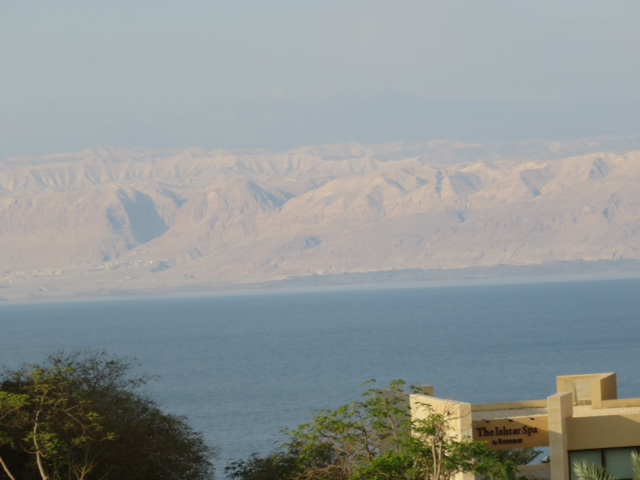
Welcome lemonade 
I can finally float.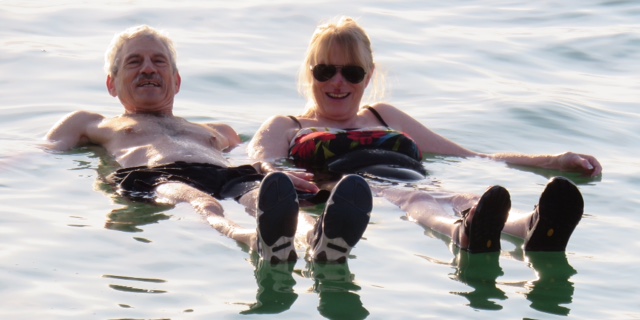
Jesus baptism site.
I will try to summarize a very complicated story that twists and turns and still has no happy ending in sight! Some from my guides, some from my reading and some from what I remember from Hebrew school over 50 years ago. And of course, all of this has my point of view. Do not take my wildly oversimplified musings as fact!
The entire region of the middle east is not historically built around nation states. It is a collection of tribal lands and other small communities held together by shared traditions or families.
The continuing conflicts really begins with Abraham and his sons. God promises him the land of Israel. Even at the beginning, there is dispute between Isaac and Ishmael as to who inherits. Jewish history says it is Isaac and that is where Jews say they have the ancestral right to the land. Palestinians disagree with this story.
The usual battles and famines occur and Jacob and the Jews end up in Egypt until Moses (Charlton Heston told that story well.) Eventually through a series of kings; Joshua, Saul,David and Solomon, Israel is established and the first great temple is built in Jerusalem.
Invaders like the Romans and Ottomans eventually destroy the temples and the Jews are expelled(diaspora). Essentially they had no home and as they spread throughout Europe for 1,000+ years, in many cases their communities were not welcomed. Most ended up in Eastern Europe and Russia.
The Middle East major players evolve from the Romans, the Byzantines/Constantinople and the Ottoman Empire which held the area for 800 years. During most of this time the Jews are mostly gone from the area and the land is populated by small groups of Arabs/Palestinians.
To be continued.............
Day 3
As we drove from Tel Aviv to the Dead Sea, we crossed Jerusalem and then headed east across the West Bank to Jordan. Until you get to Jerusalem, Israel is a flat, fertile land with Mediterranean climate. Around Jerusalem it becomes very hilly. Just east of Jerusalem, you drop from 3,000' to -1200' at the Dead Sea, and the land becomes an inhospitable desert.
Our Israeli guide expressed her views that she is concerned that the peace process is going no where because of the wall, about 150 Israeli settlements in the West Bank and now the added complication of the political pressure of the US recognizing Jerusalem as the capital. Our guide supports Jerusalem as her capital but does not feel the outside meddling is helpful. Our Jordanian guide has echoed similar thoughts and has added the fact that the Jordan River actually used to be a strong, swift river, but with Israel and Syria damming much of the water below the Galilee, essentially no water flows which greatly affects the land. While Israel is a modern country with life style similar to the the US, the conditions are much more impoverished in the West Bank. Many people work in Israel and it can be a nightmare crossing through the checkpoints each day.
Both guides seem to feel separation of the people leads to a lack of understanding and dehumanizing of the "other side as the enemy". The only thing they can suggest is to remove barriers and somehow educate young people together.
We visited Mt Nebo where Moses saw the " promised land". Then we had lunch with a Christian Jordanian family in Madaba. We were split into small groups to visit different families and it did not feel awkward at all. Dalia told us her daughter has just taken the high school graduation tests for college and her son has recently completed kindergarten. Everyone seems to know some English and the standard of living seems almost middle class from Ammon to Madaba.
Toured an amazing sight today. After walking about 1 mile through a slot canyon you start to catch a glimpse of the ancients remains of the of the Nabataean Kingdom in Petra. The ruins carved out of the sandstone truly are a wonder. A cold front that ripped through Europe got to us today with 40 mph wind driven rain and 35° temps. Made for some challenging hiking.
It will warm in a day as we get closer to Egypt.
Dahlia and her son Peter.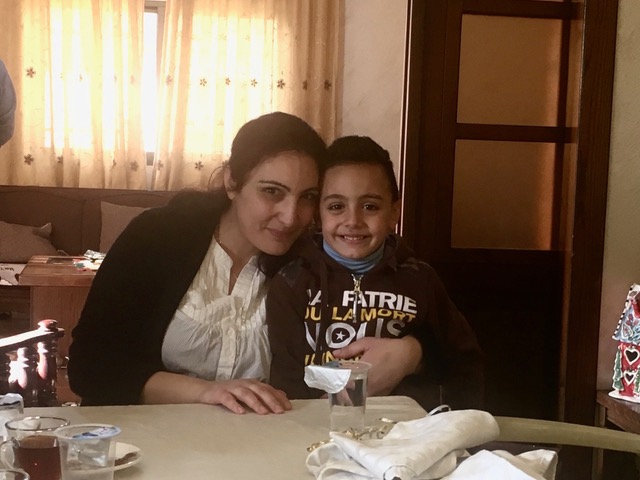
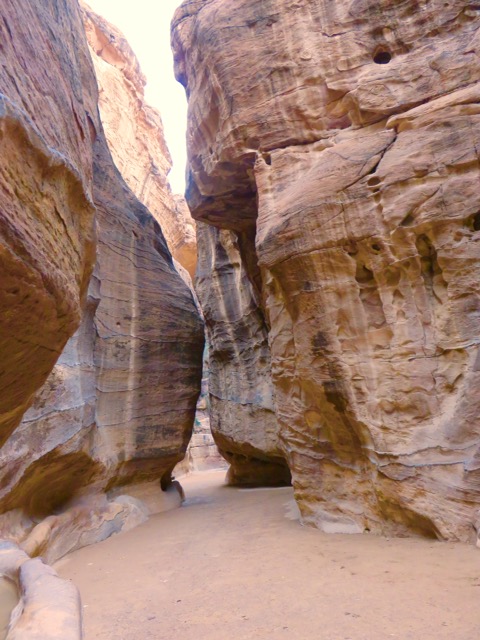
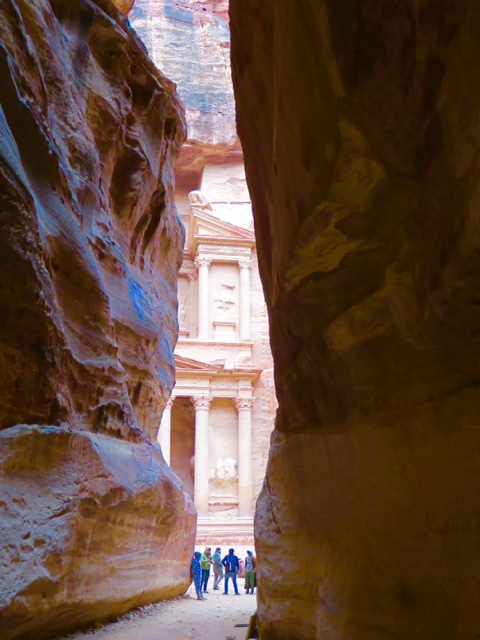
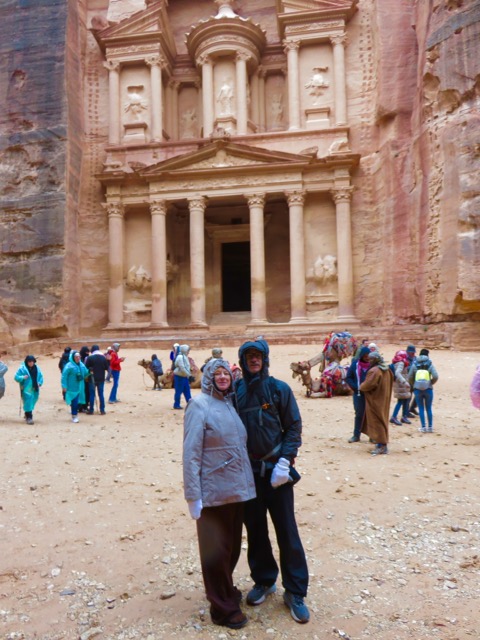
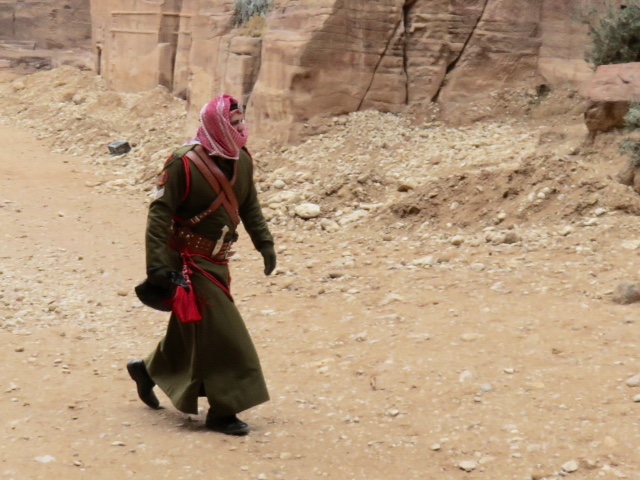
Day 4
Hi all
Our Jordanian guide, Mo, brought us to meet his family who live in Petra. His father, a retired High School principal, mother , 18 year old brother just graduating from high school and 27 year old sister who has a college degree.
The bother, Joseph, was telling us he does lots of peace/ leadership work with young people, many from Syria. I was pleasantly surprised that these young people, he says, are optimistic about the future. Life was unbearable in Syria and they can get an education in Jordan.
Then we drove south through the desert to Aqaba to meet our ship the Clio, which will be our home as we cruise up the Red Sea through the Suez Canal. We spend several hours touring Wadi Rum, using 4X4 trucks and camels. The scenery is stunning and makes the vistas of Utah seem small. This is the area that was the home base for T.E. Lawrence.
We meet our Egyptian guide, Mona, on board the Clio. she tells us that a trip like this is very much a break through for recent tourism. Few have traveled to these three countries in a single trip since the Arab Spring.
For the last several days our route has followed Moses from marker 17 to 11, without the big loop-12.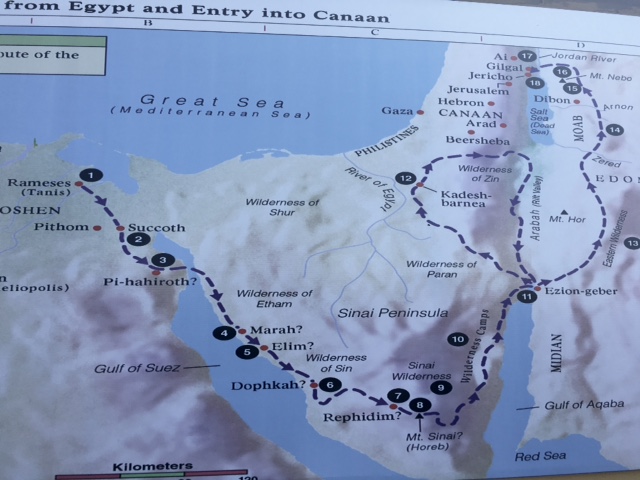
Mo' s family.
Wadi Rum National Park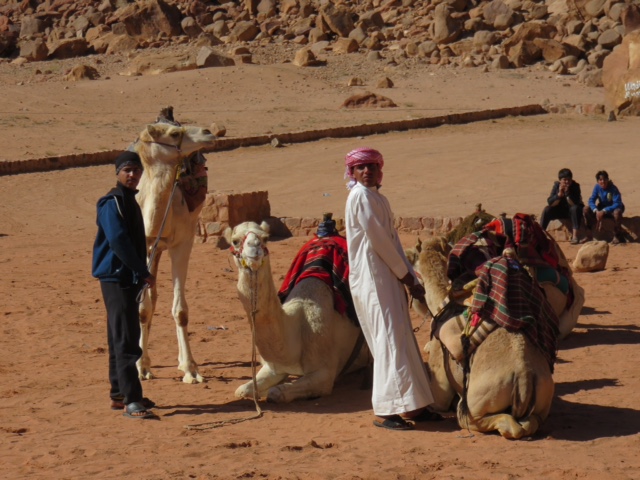

Historical Context.....Part 2
To review....the Jews are spread throughout Europe and the Middle East area is under control of colonial occupation.
........By the late 1800's Europe is entering the era of building Nation States and at the same time the Zionist movement is starting as Herzl is spreading the concept of recreating the original home for the wide spread and persecuted Jews back to Israel. During this time Tel Aviv is created as the first Jewish city.
World War I gets the ball moving. The Brits use T.E. Lawrence (you know that story) to build an Arab alliance to help defeat the Ottomans and of course, they make big promises that they do not keep. After the war, the Brits and the French carve up the Middle East. France gets Lebanon and Syria, the Brits get the rest. Eventually they separate Transjordan from Palestine. At about the same time The Balfour Doctrine creates the Palestine Mandate and promises Israel to the Zionists. For 20 years thousands of Jews immigrate to Israel until 1939, when the British close this down to quiet Arab opposition.
World War II and the holocaust bring further issues and the British bring this question to the UN to decide. In 1947 the UN decides to partition the area into a Jewish area and Palestinian area. Jordan gets east Jerusalem, and the West Bank. Egypt gets Gaza. In 1948 Israel is recognized as a nation. Almost immediately the Arab Israeli war starts and Israel expands their part of Jerusalem. About 1/2 of the Arabs living in Israel leave the country.
1967 the Six Day War. Israel gains east Jerusalem, the West Bank, Gaza, the Sinai, Golan heights. More wars until the 1977 Camp David treaty. Israel returns the Sinai and Gaza to Egypt( Egypt does not want Gaza at this point)
1993 Oslo Peace Accord. Yitzhuk Rabin and Arafat agree to establish the Palestinian Authority in the West Bank and Gaza. They are on their way to a 2 state solution. 1995 Rabin is assassinated by right wing zealots and the process falls apart.
Present Day. The West Bank is occupied or disputed territory depending on who you talk to. Israel controls the borders, the Palestinian authority has home rule. The "wall" and Israeli settlements in the West Bank are constant sources of friction and create emotional barriers for peace talks. Many Palestinians do not believe that Jews have any ancestral rights to Israel, creating further barriers to peace.
It is hard to find common ground or peaceful solutions.
Day 5
After sailing down the Gulf of Aquba to the Red Sea, Saudi Arabia was the land we were seeing to the south and the Sinai to the north. We disembarked at the port of Hurghada and then took a chartered plane about 45 minutes to Luxor and toured the Great Temples of Karnak.
While I thought Pompeii was preserved and impressive, the scale of the ruins, 5,000 years old with easily seen hieroglyphics are amazing. The construction of some of these temples started 3,000 BC. THE Engineering feats to erect the columns is pure genius.
Our tour guides are constantly thanking us for coming to Egypt. There has been little tourism since the Arab spring. The street vendors, of course, follow us everywhere and everything costs $1.
We are staying in the Winter Palace Hotel. Over 100 years old it is one of those hotels that everybody who was anybody, years ago, had to stay there. We are located right along the Nile River.
Egypt had a history of self rule until around the time of Christ. Then it was occupied by the Greeks, Roman's, Arabs, Ottomans and British, until 1954 when they got self rule under Nasser.
It is also interesting that more than one local has talked to us about politics. They liked Obama. Their politics is complicated. To get the Sinai back, they signed a treaty with Israel. Most of the Muslims here are Sunni. The surrounding Arab countries don't like the fact that they recognize Israel, as few countries in the region do.
On the other hand they are very welcoming to us. Part of that probably is the many years with few tourists. But, it is on the rebound now.
High tea at the Winter Palace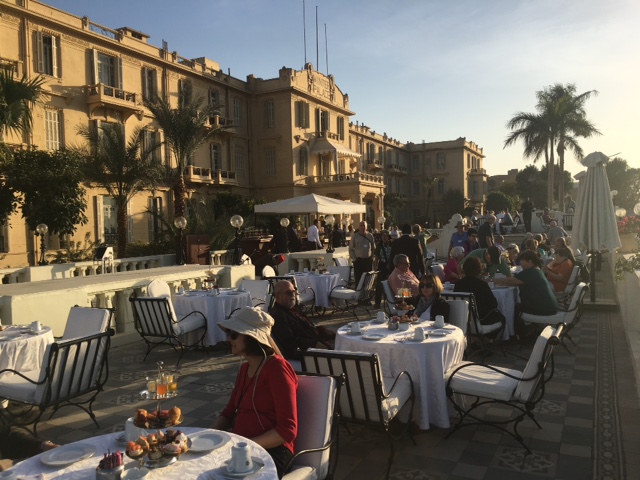
Sphinx line the entrance to Karnak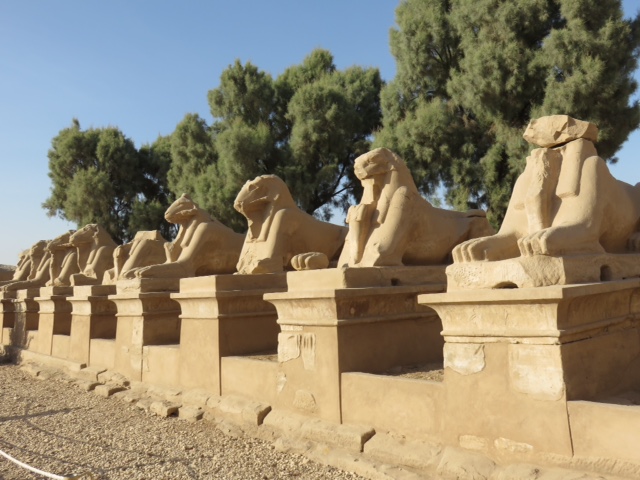

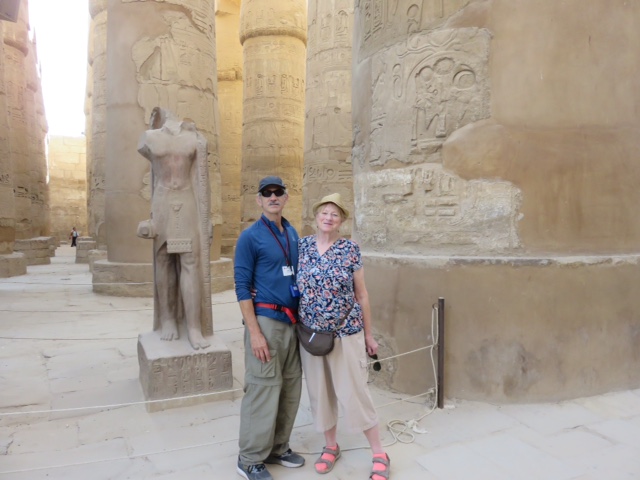
Walking along the Nile
Day 6
I did not think anything could top what we saw yesterday....... but I was wrong. What a day. Up early to see the balloons floating over the Nile. Then we headed out to the Valley of the Kings. This desert valley is where pharaohs were entombed starting about 1,500 bc. Most of the tombs were looted but the carvings and colors are still amazing. We visited Ramses, Tut and others. Most of the tourists were Egyptians. They are very proud of their ancient heritage. According to our guide most Egyptians have ancestry that goes back to these early times.
We sailed across the Nile on a felucca. We also visited a farmer and had lunch with him and his family. The son of the towns mayor came by just to greet us and say how pleased they were to see us visiting their village.
Then we flew back to the Clio and are now making our way north through the Gulf of Suez. As we flew the 150 miles from Luxor to the Red Sea, it is so clear how the arable, livable part of Egypt is concentrated almost entirely to a few miles around the Nile and around the coast. The rest of the country is desert with nobody around.
We travel in a convoy of 4 giant buses with only 20 people on each bus. Today was the first time we were on the first bus and saw our lead pickup truck filled with black hooded and heavily armed security force that has been hired to keep us safe.

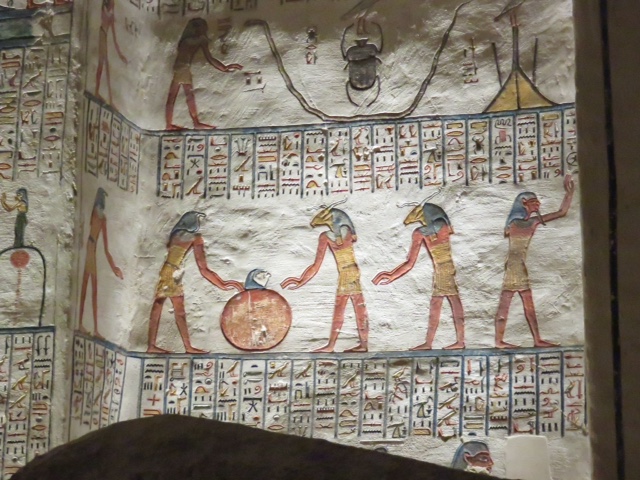

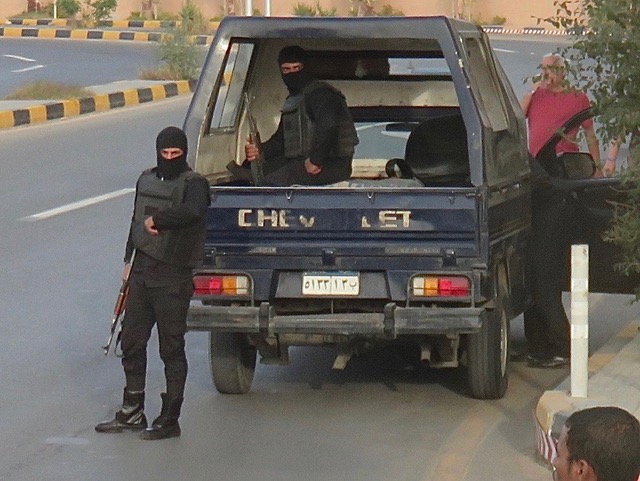
Day 7
We sailed north and in the morning we docked at the port Ain Sokhna, then we boarded buses for the 2 hour drive to Cairo and Giza. Again our 4 buses had armed security on the bus, pickup trucks with several heavily armed para-military types and we even had a police escort who seemed to block some intersections as we passed. This country is HUNGRY for tourism and they are taking no chances of having any issues.
Our first stop for lunch was at the historic old Mena House. The dining room overlooks the pyramids. Then we joined the chaotic scene surrounding the great pyramids. Camels, horses and LOTS of vendors selling many things for $1. It was interesting that 90% of the visitors were local people as there are still very few foreign tourists.
Bette and I entered one of the pyramids and steeply climbed to the burial chamber. Then we climbed high to a wonderful panorama point to see the 3 great pyramids together and ended at sunset by the great sphinx . Leaving Cairo in rush hour traffic was interesting. The Cairo area has 20 million people. It is a messy, trashy place with not nearly enough roads to handle the traffic. They are building a new capital district about 45 minutes south of the city.
Mona, our guide shared lots of info about Egyptians daily life. Both Jordan and Egypt, in the rural areas have lots of arranged marriages. Mom must approve and will take matters in her own hands. Most sons end up building another story on top of the family home when they get married. Many fireworks result between bride and mother-in law.
In the cities these customs are not as strictly followed. It seems like most are not very religious and whether woman cover their head Is strictly a personal choice. Woman have mostly the same freedoms as men with the exception of inheritance as land goes to the sons. In Egypt, monthly salaries will range from $300 to $1,000. There are many poor people but there is a tradition of people helping their neighbors.
Mona explained some of the political history. Nasser took control and liberated the country in 1952 after over 2,000 years of colonial occupation. He was very popular when he nationalized the land and gave each family 5 acres. Nasser did not get debt and arms concessions from the west so he aligned himself with the Soviets. When he died his Vice President, Sadat, took power. He is loved by the people. The Sinai was lost to Israel in the 1967 6 day war. He gradually got it back with The signing of the Israel-Egypt peace treaty in 1977 but this led to the Sadat assassination by right wing extremists in 1981. His Vice President, Mubarak took control until he was forced out as a result of the Arab spring in 2011.
Mona lives in Cairo and was telling us how frightening that time was. Young people started the movement and the country joined in to fight corruption and police brutality. The Muslim Brotherhood was the only organized political party and they quickly stepped into the power vacuum. After Mubarak was removed from power the Brotherhood won the first election which actuallly surprised the people as they really thought that the formed Vice President would win the election. It did not take long for people to realize a mistake had been made. The Brotherhood was moving towards a strict religious state which is not what the people wanted. Within 1 year the people rose again and got help from the military and forced Morsi out. People were not happy with the right wing religious direction he was moving and they said he was embarrassing the country on the international stage. The military supported the people and the general was elected president. So far, people are much happier now and he is favored to be re-elected. But for several years there was almost a lawless environment and deep economic depression.
Sailing through the Suez Canal today and will eventually dock in Haifa, Israel.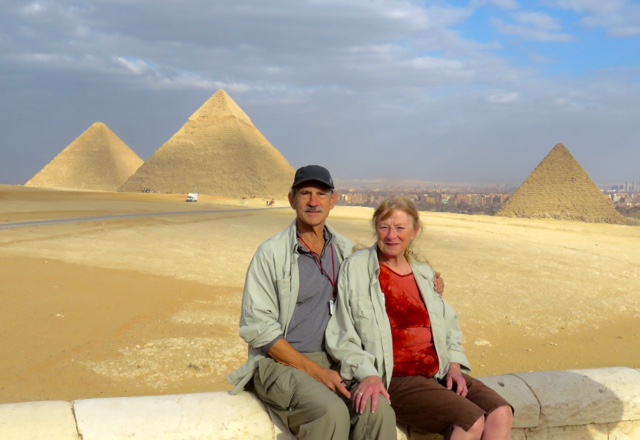
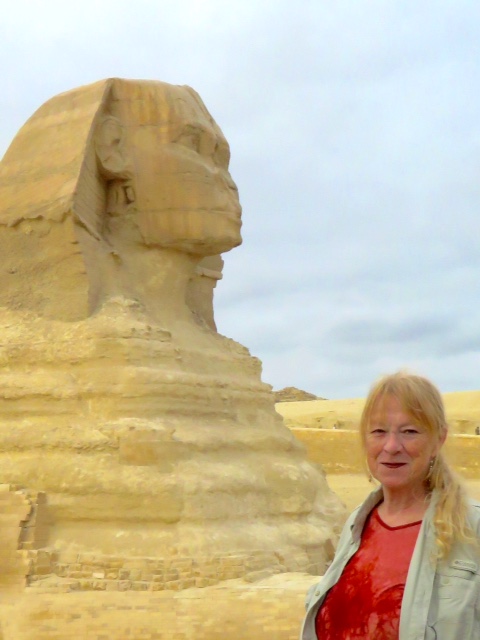
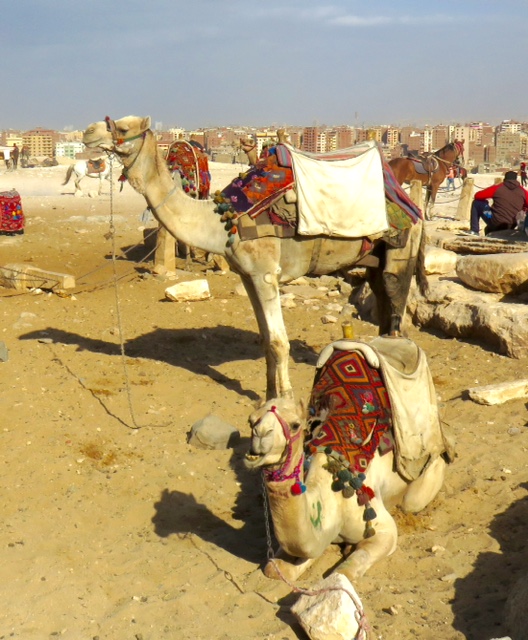
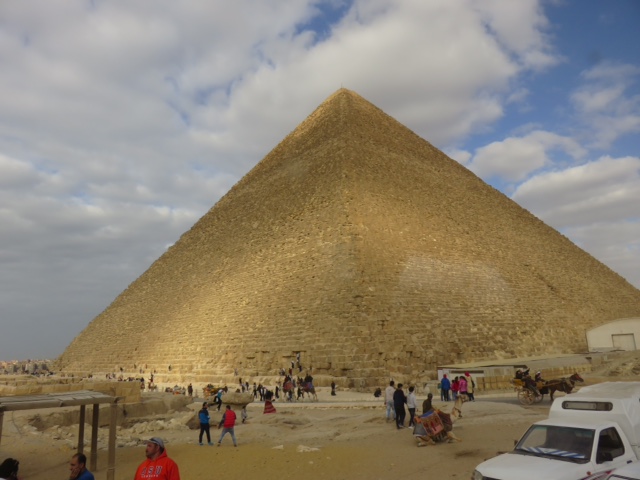
Day 8
Yesterday we headed first to the Sea of Galilee and saw the sites where Jesus delivered the sermon on the mount. Then we climbed up on the Golan Heights. It is obvious how necessary for Israeli security that they control the high ground above the plains surrounding the Galilee. We ate lunch at a kibbutz and then a kibbutz manager shared with us the experience of the Valley of Tears. During the Syrian/ Egyptians surprise attack of the 1973 Yom Kipper War, the Israelis were not prepared. The Syrians charged the Golan Heights with 1,000 modern tanks and the IDF only had 150 older tanks. The first few days were touch and go with lots of casualties but ultimately the Israelis held the high ground. We asked how is this possible and his answer was they have NO CHOICE but to win every war. If they fail their families are only a few miles in back of them and then the country is lost.
We asked him about the situation of the West Bank and he refuses to call it occupied land. In his mind, they won it in the 1967 war and he does not see any reason for Israel to give back the settlements.
As we drove the Golan Heights there are signs about land mines off the road and there are Israeli and UN forces in the area. From the high point as we are looking into Syria, Damascus is only 40 miles away
We have now heard from three groups of people from 3 countries involved in this quagmire . Very, very interesting and diverging perspectives.
Today we walked through the Arab section of Haifa, Wadi Nusa Nisnas. Our guide, Noa seemed to know everyone. We visited several shops, they all graciously gave us a sample of whatever food they were selling and we talked about Israeli-Palestinian coexistence. The people who live in this area are Arabs but they also have Israeli citizenship. The area is loaded with public art. Many times there were paintings in a window of the long ago inhabitants of the house who left in 1948, after Israel became a nation.
Tomorrow we say goodbye to the Clio crew( almost as many crew as passengers) and finally will make our way to the old section of Jerusalem.
Sea of Galilee 
IDF watching over the Syrian border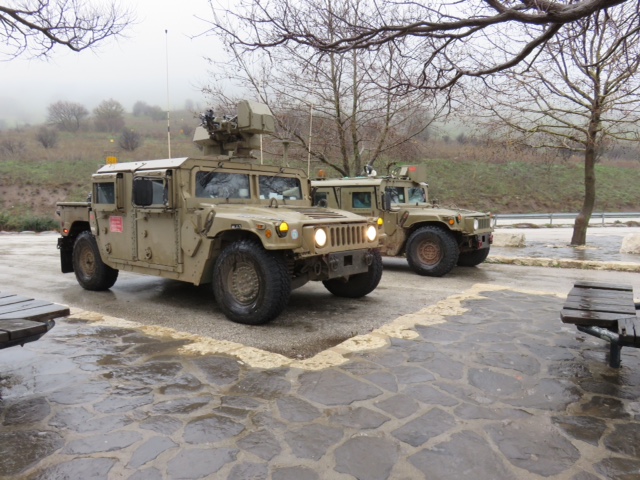
Wadi Nusa Nisna
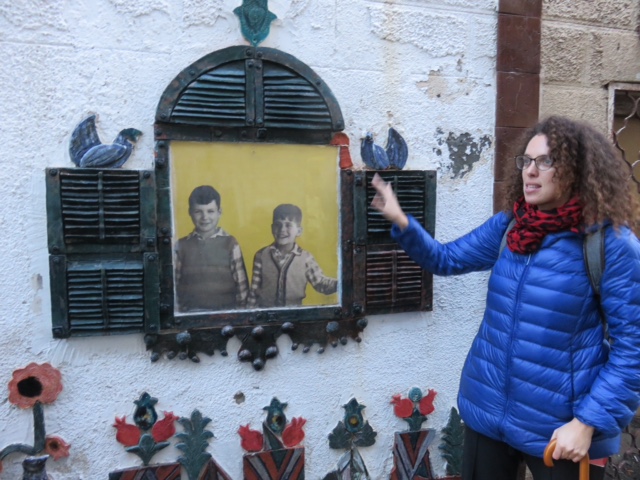 .
.
Day 9
Today we meandered around the Old City of Jerusalem. Passing through the Jaffa Gate and the Armenian, Muslim, Christian and Jewish sections. We walked along the Via Dolarosa, joined the many pilgrims congregating at the Holy Sepulcher Church and ended up at the Western Wall. The entire experience was very overwhelming. But, I did not forget all of you and left a prayer for you at the wall.
Tomorrow we start the long journey home, leaving the hotel at 3:30 am!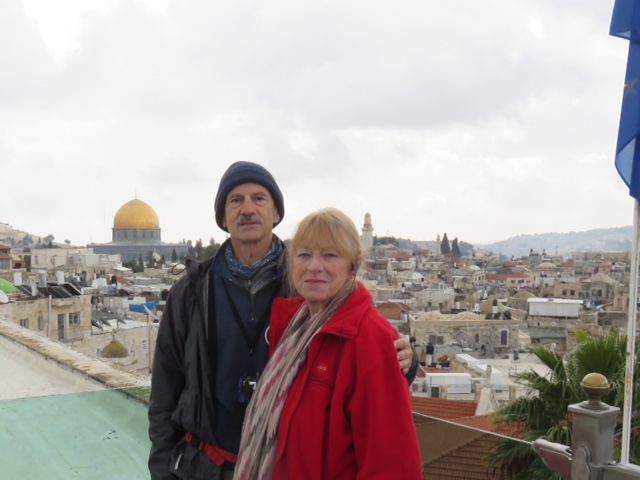

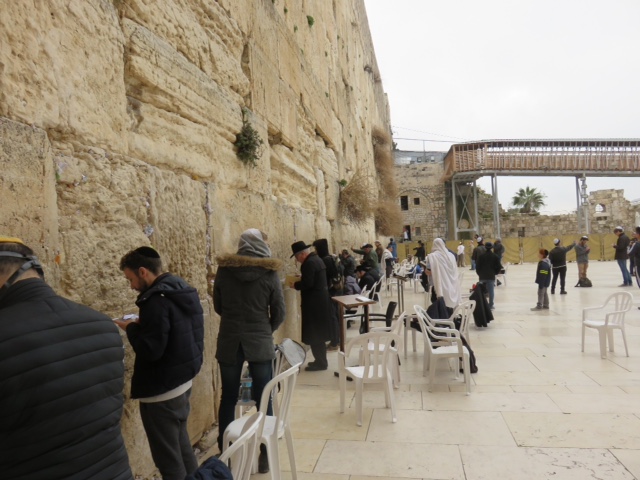
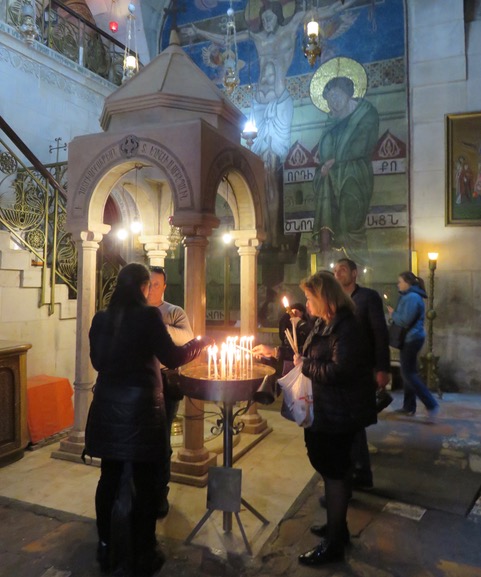
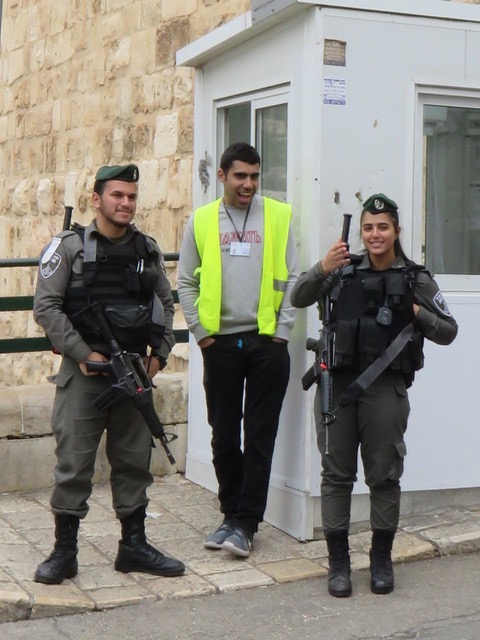
Barry & Bette